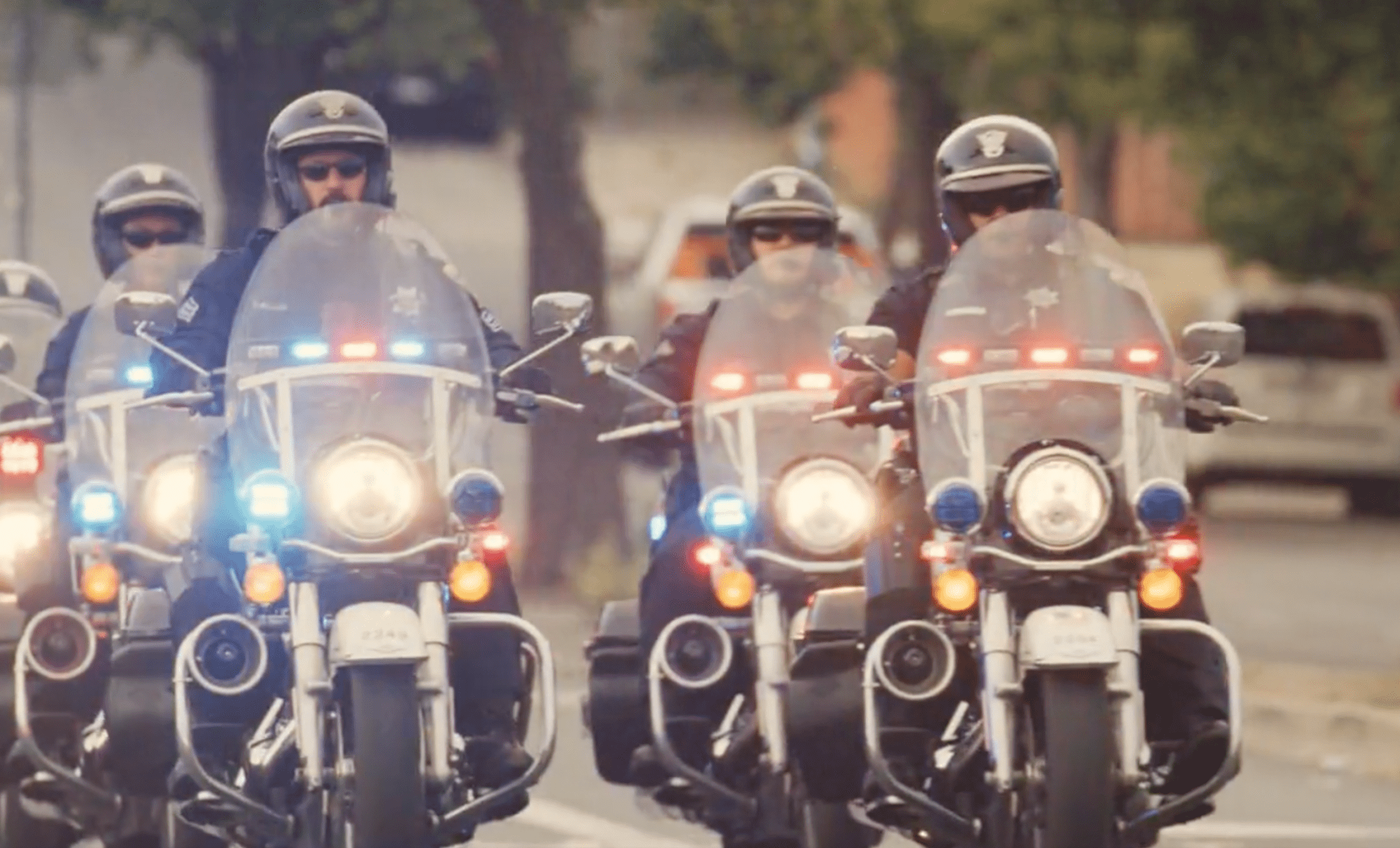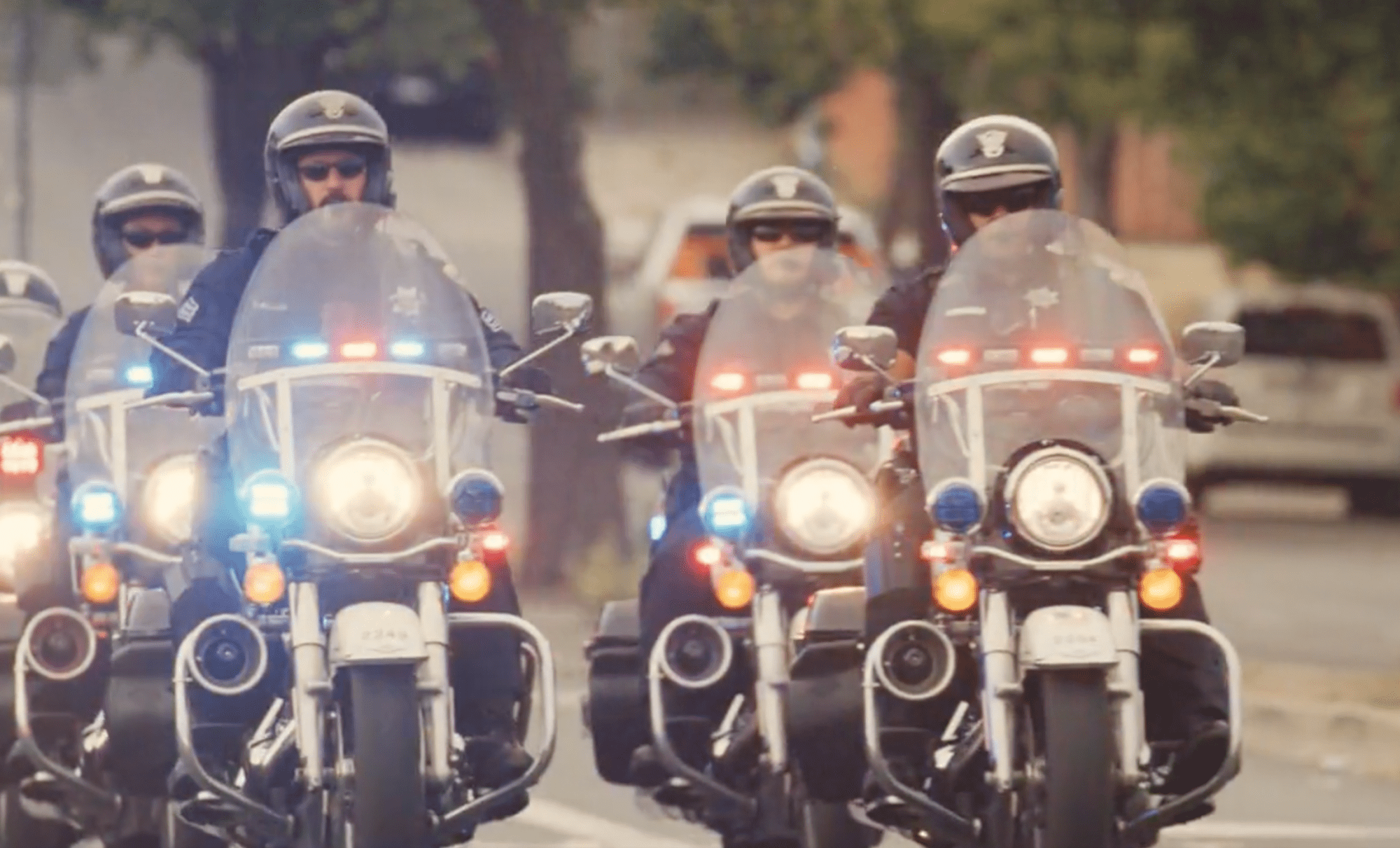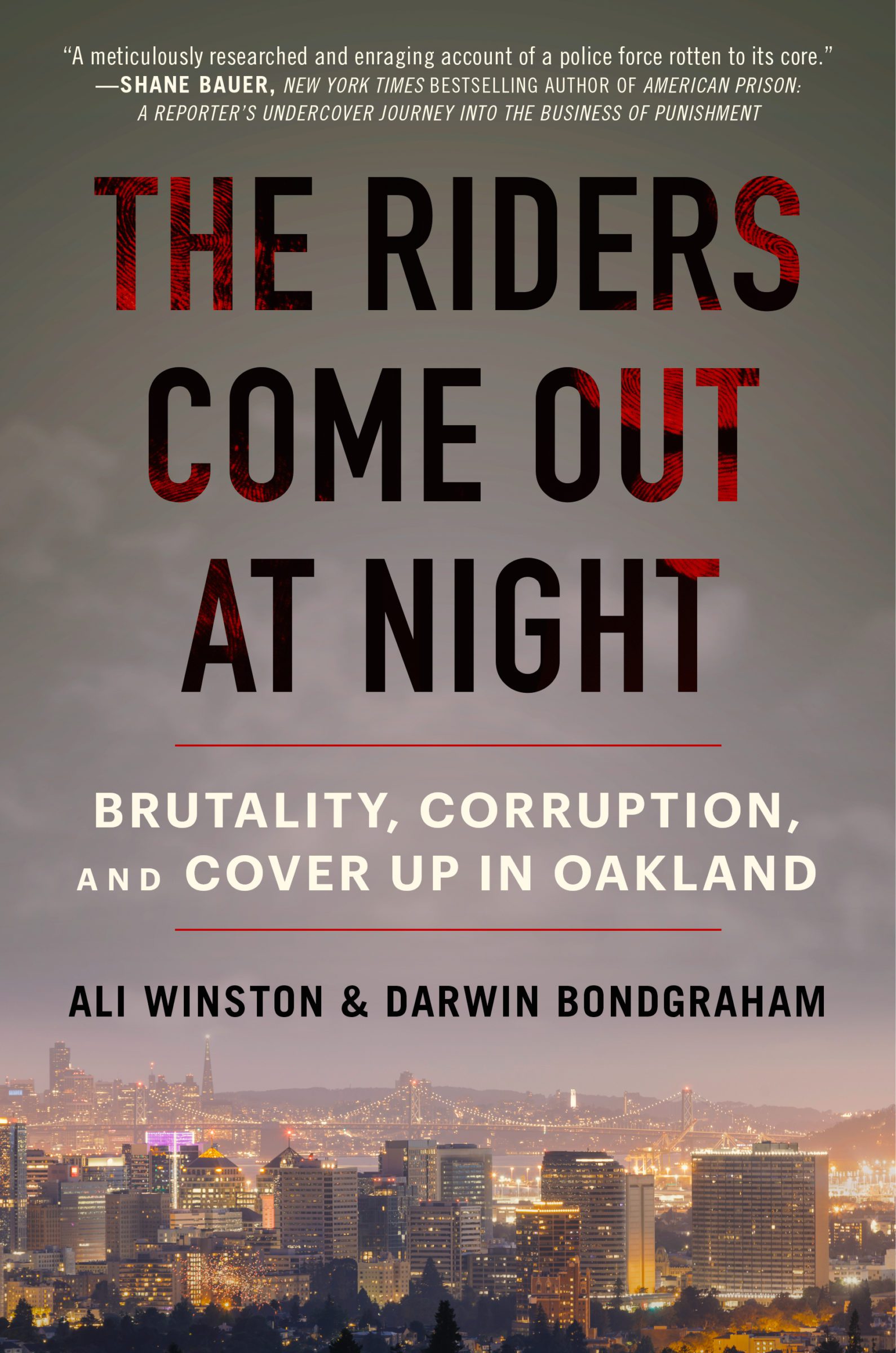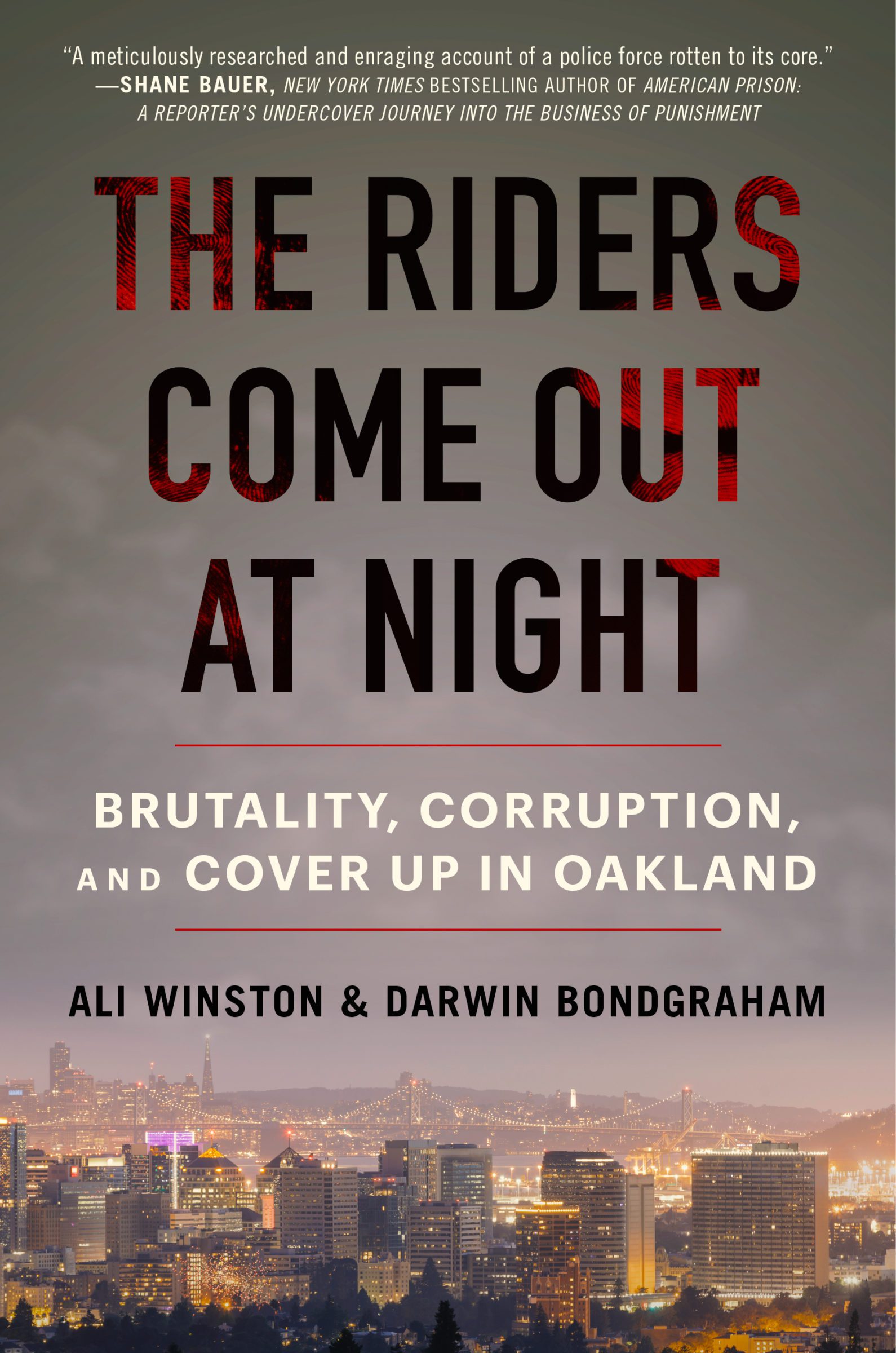Oakland’s “Riders” Scandal and the Fraught Road to Police Reform
The Riders Come Out at Night, a new book that draws on years of investigative reporting, presents a damning portrait of the Oakland Police Department's abuses and resistance to change.
Piper French | January 13, 2023


For years, a gang of police officers beat and brutalize civilians, arrest innocent people, plant drugs on suspects, and falsify reports to hide evidence of their crimes. They force their targets to sign false confessions. They escalate every encounter. They kill dogs; sometimes they kill people. And then—they get caught.
The Riders Scandal rattled the city of Oakland in 2001, leading to a historic prosecution, a massive civil-rights lawsuit, and decades of federal oversight. As investigative reporters Ali Winston and Darwin BondGraham detail in The Riders Come out at Night, their exhaustive new history of the Oakland Police Department, the fate of the men on trial essentially hinged on a central question: were these officers bad apples, or were their actions evidence of a far deeper rot?
The Alameda County DA’s prosecution strategy relied on painting the “Riders,” as the gang came to be known, as rogue cops within an otherwise functional system. It’s not hard to imagine why the DA might be invested in excising the Riders from the rest of the OPD. I noticed the same dynamic during the trial of Derek Chauvin: other cops testified over and over that his actions were against procedure. By proving the aberrance of the few, the state can demonstrate guilt—and preserve the good name of the many.
Meanwhile, in arguing that the Riders’ actions were within procedure, the defense advanced a far more damning indictment of the OPD, inadvertently making an argument more common among abolitionist critics of American policing. The Riders’ lawyer, Winston and BondGraham write, called the Oakland police chief to the stand, then used his testimony to “show the jury a picture of a city where cops had been told to be aggressive, put their hands on suspects, hit the corners, and attack the drug trade head-on. Their actions, no matter how egregious, were all in the name of public safety and hitting the mayor’s magic 20 percent crime drop.” The Riders, in other words, “weren’t rogue cops; they were following orders.” The fact that the case would end in two separate mistrials, with one officer ultimately acquitted, suggests that the bad apple theory failed to sufficiently compel jurors. And though Winston and BondGraham argue repeatedly that the Riders were far from rogue cops, the real question they’re interested in exploring is slightly different.
What are the preconditions that allow a group like the Riders to flourish, the journalists ask, and what can be done to preclude those conditions? Or, in plainer language: why are police the way they are—and is it possible for them to change?
Winston and BondGraham answer the first half of this question clearly, devoting a considerable amount of Riders to the OPD’s 19th-century origins as a violent and graft-prone institution that exploited and suppressed minority groups.
“During the first century of the department’s existence, custom and practice condoned the quick use of the nightstick and revolver to control restive populations: labor unions, the Chinese, and white ethnic immigrants who upset the city’s image of itself as a pious, middle-class, Anglo-Saxon settlement,” they write. Dozens of Oakland police officers were members of the KKK; at one point, Winston and BondGraham refer to the Klan as night riders, wording that draws a direct line between the Riders and these grim forebears, especially given the supposed origin of the nickname (a Black man who’d been stopped for a traffic violation allegedly thanked the officer for being respectful, and added, “This isn’t at all what it’s like at night. At night, the Riders come out.”)
When African Americans started arriving in Oakland during the Great Migration, the combative, us-vs.-them mentality the OPD had cultivated against immigrants and radicals was neatly transposed onto this new population, with a heaping dose of anti-Black racial hatred thrown in to boot. In 1950, during one of the city’s first panels on police brutality, a local civil rights attorney testified that “the Negro citizens of Oakland live in daily and nightly terror of the Oakland Police Department.” The chief of police, meanwhile, dismissed this criticism as a Communist plot.
Whether police can change, though, is a trickier question—and a divisive one, especially on the left. The reporters lean into this tension. To say that reform is impossible, they argue, discredits the painstaking work of activists, lawyers, journalists, and ordinary people to expose the department’s abuses and bring it to heel. For evidence of this truth, look no further than Riders itself, which would not have been possible without both authors’ years of dedicated reporting on the OPD, statewide legislative reforms that required law enforcement to turn over more internal records, and the hard work of an attorney who sued on behalf of the two journalists, forcing OPD to comply with these new laws. To contend that nothing can be done would be to imply that there is no reason to fight.


But there are limits, and Winston and BondGraham, who spent years covering the OPD as local investigative journalists, explore them in excruciating detail. Take the Riders whistleblower Keith Batt, a rookie whose testimony allowed the case to go to trial and was key in establishing the federal consent decree that’s covered the department since. On its face, the story pits the Riders’ “bad cops” against Batt, a “good cop” who did the right thing under extraordinarily difficult circumstances. But without negating anyone’s agency or moral culpability, Winston and BondGraham show how it’s ultimately less about the individual will of the officers than what the system they work within condones—and encourages. The department rewards and promotes aggressive, confrontation-prone cops, and constrains ethical ones: taking them off assignments, making their work lives hell, and often driving them to quit. Two Black officers who are presented as critics of the OPD’s practices eventually leave; one ends up writing a sociology dissertation about the force’s endemic racism.
For every Batt, there are dozens of officers depicted in this book who look the other way, and face few consequences for it. The whistleblower ultimately served just 17 days in the OPD. He was harassed relentlessly, essentially forced to resign, and found himself threatened by other cops when they crossed paths afterward—even as one of the Riders successfully sued the city for wrongful termination, walking away with $1.5 million in damages. Someone illegally pulled Batt’s DMV records, accessing his home address and other personal information. And with the scariest of the Riders remaining a fugitive from justice today, Batt is probably still looking over his shoulder more than two decades later.
Riders begins with the book’s eponymous scandal, then zooms out to capture the historical and political context that led up to it, the fight to prosecute the officers at its center, and two prominent local civil rights lawyers’ simultaneous efforts to hold the department accountable. The result: a federal consent decree—a court-enforced reform agreement—from which the department has still not emerged, two decades later.
Winston and BondGraham make the stakes clear. The consent decree is the external accountability tool for reforming American police departments, and Oakland has been under one longer than anyone—even LA, where the Rampart scandal, which came on the heels of the Rodney King beating, occasioned one in 2000. “More has been done to try to reform the Oakland Police Department than any other police force in the United States,” they write.
From the beginning, though, the authors sow doubt as to whether the OPD will ever be able to fully comply with the terms of the decree, a comprehensive settlement agreement that required the OPD to overhaul its training and internal investigations, implement an ‘early warning system’ to root out problem officers, and make sure all officers were supervised in an attempt to avoid the lack of oversight that led to the Riders’ abuses.
Many in the department are openly hostile toward its imposition. (“You’ve got to stop using that word reform,” a captain nicknamed ‘Maniac’ tells one of the external monitors, suggesting that his men will bristle at even the mention of change.) There is a culture of silence and internal loyalty around officer misconduct that extends even to the most egregious cases. To call OPD’s Internal Affairs team merely feckless feels charitable; the division often gives the impression of actively stonewalling investigations. Punishments, when they are occasionally meted out, are downgraded, and then downgraded again; it’s not uncommon for officers to resign rather than accept their slap on the wrist. The department’s union, the Oakland Police Officers Association, is willing to spend whatever it takes to defend its men, which often results in cops who brutalize and kill civilians getting their jobs back through arbitration.
And Winston and BondGraham also show how opportunities for change have been thwarted by historical vicissitudes: the war on drugs; state and municipal budget crises; the subprime mortgage crisis, which disproportionately targeted Black and Latinx homeowners; the leadership of politicians like Jerry Brown, whose lefty-radio vibes quickly morphed into law-and-order rhetoric in order to win his mayoral race in the late ‘90s. The book doubles as a rich political history of Oakland, the birthplace of the Black Panthers and a city that has been repeatedly devastated by austerity and racist policies.
“So long as Oakland and the rest of America is riven by extreme racial and class inequalities and the power of the federal government is not brought to repair the economies of destitute cities and rural areas, and deal with the intergenerational trauma that leads to despair and hopelessness,” they write, “then it’s very likely the police will continue serving more or less the same function they have for well over a half century: containing and repressing the symptoms of broader social problems through violence.”
The second half of the book explores OPD’s glacial progress post-consent decree, which is continually marred by the revelation of scandal after scandal. At one point, Winston and BondGraham describe this advancement as “two steps forward, and one step back.” Often, reading Riders, it felt more like the other way around.
There’s a moment around 2014 where things are starting to look up: For the first time in decades, the OPD had a chief interested in reform and willing to stand up to the police association. The department was finally making good progress on its settlement agreement tasks. “In just a year, the Oakland PD went from utter failure to a national leader in policing reforms,” the journalists write.
Reading this feels sort of like watching the beginning of a horror movie: you suspect that something awful is coming, even as the characters remain unaware. And the next scandal to be revealed is one of the most stomach-churning in the book: the Celeste Guap case. Guap was the pseudonym of a young woman named Jasmine Abuslin who was groomed, abused, and pimped out, both before and after her 18th birthday, by multiple OPD officers as well as cops from a laundry list of other departments in the region.
Cases like Abuslin’s stand out for their shock value. The abuse was discovered when a cop who groomed and statutorily raped the girl shot himself in the head and left a damning suicide note. That decision unleashed a chain of events that eventually lead investigators to realize that the cop had most likely killed his wife several years earlier, staged it as a suicide, and had the whole thing covered up by the department. This was after Abuslin revealed the abuse directly to an OPD sergeant, who responded to her by writing “tell me you were an adult.” The internal investigation went nowhere.
But the individual instances of cruelty, incompetence, misconduct, and malfeasance detailed in Riders can start to blur together. In a way this is the point. The book does center the Riders scandal, but it doesn’t argue for its exceptionalism; those officers’ wrongdoing is presented alongside many, many more examples big and small, lurid and mundane.
One in particular struck me. It could have happened in any police department in the country. It’s the case of Spencer Lucas, a young Black man who was stopped by OPD officers while driving to a friend’s house in 2005. Lucas was just 30 days away from completing a three-year parole term when he was pulled over. He was essentially homeless, but otherwise doing well. The cops seemed to want to mess with him. When they found out he was on parole, they got their chance. They strip-searched him in broad daylight, finding nothing. Even after calling his parole officer and finding out he’d been complying with all his terms, they forced him all over the city in handcuffs, trying to find something that would constitute a violation of his parole. After hours of this, they showed up at the home of his estranged wife, searched it, and found a BB gun.
In this brief anecdote, we see this institution, even under federal decree to do better, return to familiar habits: doing nothing to keep people safe, but instead intruding greedily into their private lives, searching for ways to snatch them back within its clutches, and fostering only rage and humiliation and despair in those it targets. As a result of that encounter, Lucas ended up going back to prison for almost a year.


